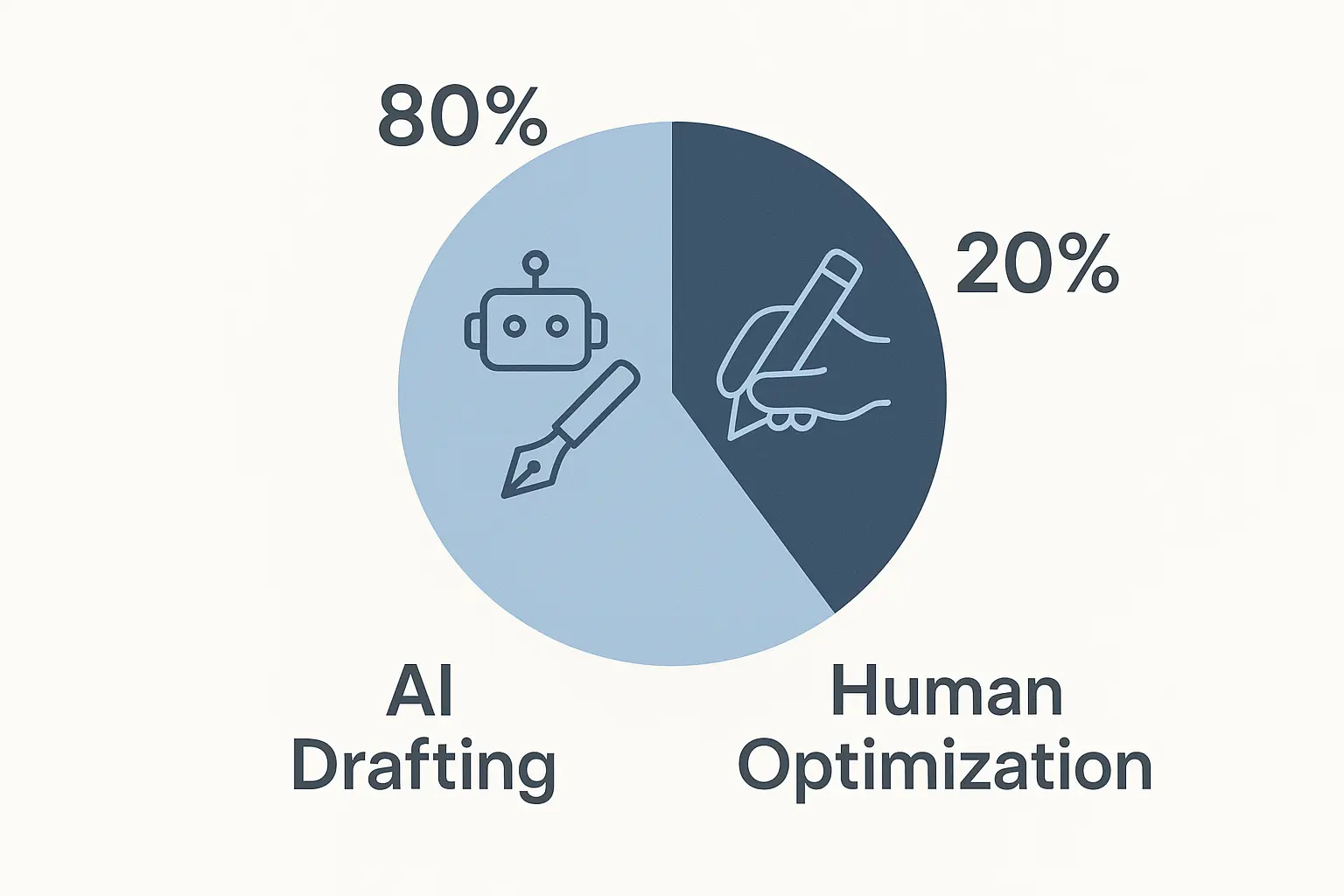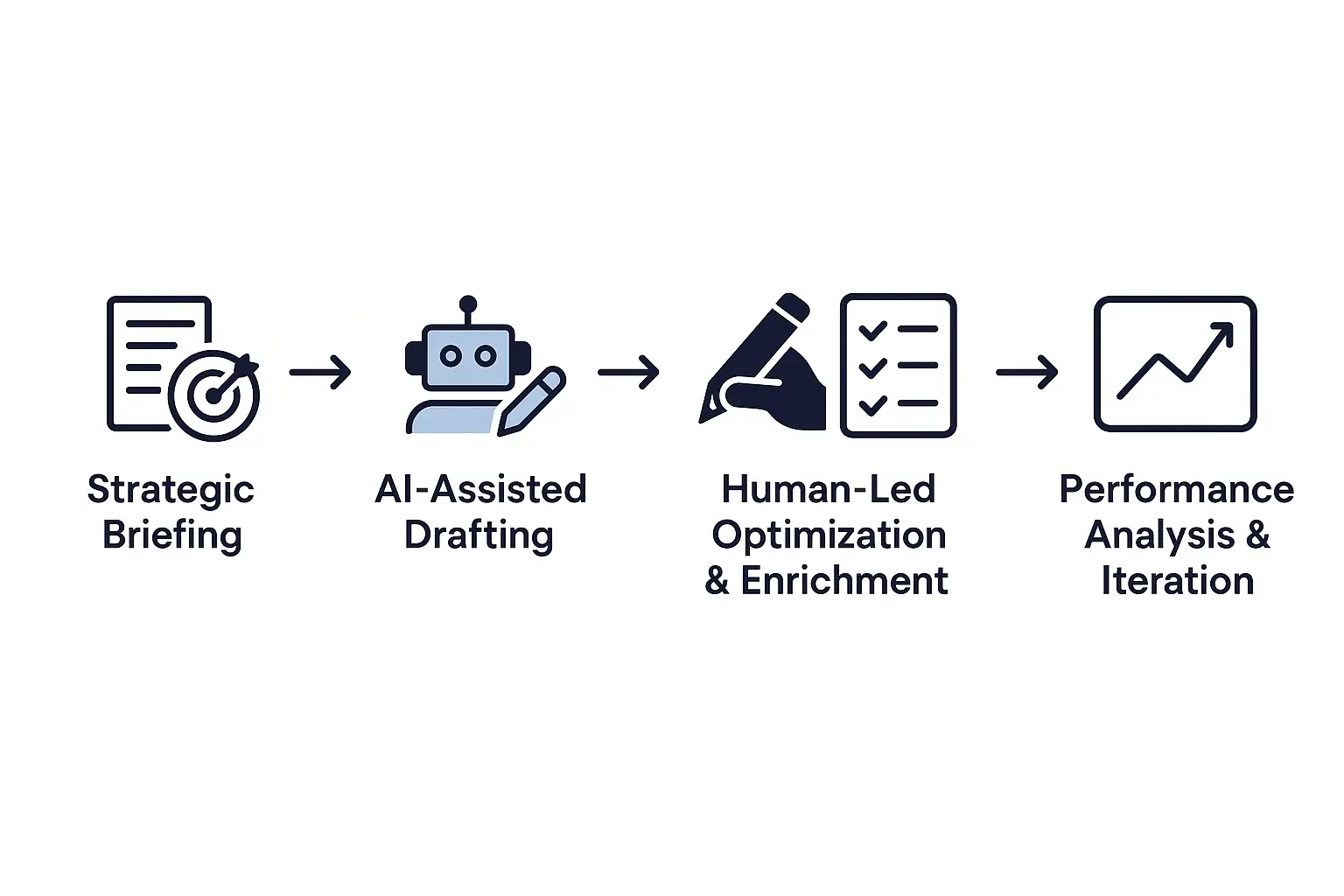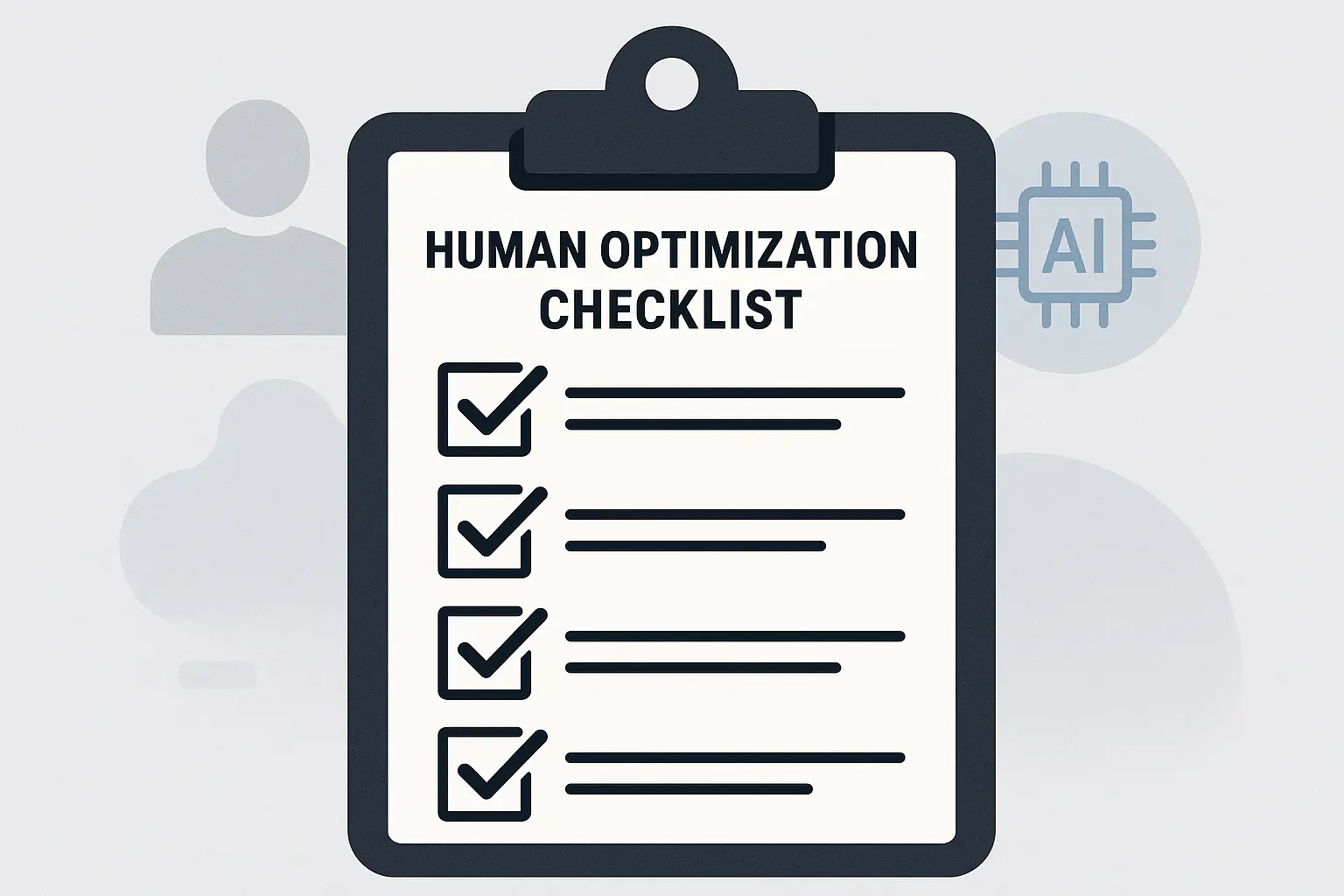Ever feel like your agency is stuck on a content treadmill? You’re constantly running to keep up with client demands, publishing schedules, and the ever-present need for more.
But scaling content often feels like a choice between two flawed options: go slow and expensive with a purely manual process, or go fast and generic with purely AI-generated content.
What if there’s a third way? A method that blends the speed of machines with the irreplaceable insight of a human expert.
There is. It’s called the hybrid content workflow, and it’s not about replacing your strategists—it’s about unlocking them. By letting AI handle about 80% of the initial drafting, you free up your team to focus on the critical 20% that actually drives results: strategy, originality, and optimization.
The Content Conundrum: Why Old Models Are Breaking
For years, agencies have relied on a time-intensive, manual content process. A strategist spends hours researching, outlining, and writing, then passes the draft to an editor for another round of work. The result is high-quality content, but the process is slow and incredibly difficult to scale.
Then, generative AI exploded onto the scene, promising a new era of efficiency. But many who jumped in headfirst quickly hit a wall. A recent survey of marketers found that 51% say their biggest challenge with GenAI is creating content that isn’t generic. They discovered that AI, on its own, is great at mimicking patterns but poor at creating genuine value. It lacks perspective, brand voice, and the nuanced understanding of a target audience.
This puts agencies in a tough spot:
The Manual Path: High quality, but high cost and low scalability.
The Pure AI Path: High speed, but low quality and a high risk of being generic.
The solution isn’t to pick one, but to blend the best of both.
Introducing the 80/20 Hybrid Workflow
The hybrid content workflow is a system for strategically dividing labor between artificial intelligence and human intelligence.
AI handles the 80%: The heavy lifting of initial research synthesis, structuring, and first-draft creation.
Humans handle the 20%: The high-value tasks of strategic direction, fact-checking, injecting original insights, and optimizing for conversion.
Think of AI as a brilliant but incredibly junior research assistant. You wouldn’t ask it to define your client’s entire Q3 content strategy, but you’d absolutely have it gather sources, summarize key points, and assemble a rough draft for you to refine. This approach is already making a huge impact. Marketers report that AI helps them create content more quickly (46.7%) and brainstorm ideas (37.5%).
This isn’t just theory; the productivity gains are real. A landmark study from Stanford and MIT found that access to a generative AI assistant increased worker productivity by 14% on average. Even more telling, the least experienced workers saw gains as high as 35%, showing how AI can level the playing field by handling foundational tasks.

Your Step-by-Step Guide to the Hybrid Workflow
So, how do you put this into practice? Here’s a breakdown of the process.
Step 1: Human-Led Strategy & Briefing (The Foundation)
This is the most important step, and it’s 100% human. Before AI writes a single word, your strategist must define the “why” and “who.”
- Audience & Intent: Who is this content for? What problem are they trying to solve?
- Goals: What should this article accomplish? Drive demo sign-ups? Educate on a key concept?
- Keywords & Topics: What primary and secondary keywords do we need to target?
- Angle & Outline: What unique perspective will we take? What is the logical flow of the argument?
A detailed brief is the instruction manual for your AI assistant. The quality of your input dictates the quality of the output. For agencies looking to perfect this stage, creating a rock-solid blueprint is non-negotiable. Investing time in a detailed guide to creating SEO content briefs can make the entire downstream process exponentially more efficient.
Step 2: AI-Powered Drafting (The First 80%)
With a strong brief in hand, you can now turn to your AI tool. Feed it the outline, key points, target audience profile, and keywords. Ask it to generate a first draft based only on these instructions.
This is where you gain incredible speed. In minutes, the AI can assemble a structurally sound article that incorporates your key topics and follows your outline. It can synthesize research, explain basic concepts, and build out the body of the piece. The result isn’t a finished product, but it’s a massive head start—a solid C+ draft that gets you 80% of the way there.
Step 3: Human-Led Optimization & Editing (The Critical 20%)
This is where your team’s expertise transforms a generic draft into a high-performing asset. The goal here is to elevate the content from acceptable to exceptional.
Here’s what that involves:
-
Fact-Checking: AI tools are notorious for “hallucinating” or presenting false information confidently. A human expert must verify every statistic, claim, and reference.
-
Injecting E-E-A-T: This is Google’s acronym for Experience, Expertise, Authoritativeness, and Trustworthiness. A human strategist adds personal anecdotes, proprietary data, expert quotes, and unique industry insights an AI could never replicate.
-
Refining Brand Voice: AI drafts often sound robotic. Your team must rewrite sentences to align with your client’s specific tone—be it witty, formal, inspirational, or technical.
-
Conversion Optimization: Where should the calls-to-action (CTAs) go? How can we make the introduction more compelling? What internal links will guide the reader deeper into the site?
-
Polishing for Flow: The final read-through ensures the article flows logically, transitions are smooth, and the language is clear and engaging.
This human-led final stage is what separates content that merely exists from content that performs.

The ROI of Working Smarter, Not Harder
Adopting a hybrid workflow doesn’t just make life easier; it delivers tangible business results for your agency.
-
Massive Scalability: Your team can produce two to three times more content, allowing you to take on more clients without immediately hiring more writers.
-
Improved Profitability: By reducing the human hours required for each piece of content, you increase the profit margin on your content services.
-
Elevated Team Roles: Your writers become editors and strategists. This shift makes their roles more strategic and valuable, improving job satisfaction and retention.
-
Consistent Quality: By systemizing the process, you ensure a consistent level of quality across all client accounts, protecting your agency’s reputation.

Frequently Asked Questions (FAQ)
Will Google penalize me for using AI-generated content?
No. Google’s official stance is that it rewards high-quality content, regardless of how it’s produced. Its systems are designed to penalize spammy, low-value content, not AI-assisted content. A well-executed hybrid workflow produces helpful, original content that aligns perfectly with Google’s guidelines. The modern search landscape is complex, and understanding the role of AI in modern SEO strategies is key to staying ahead.
What are the best AI tools for this workflow?
Many excellent tools are available, such as ChatGPT, Jasper, and Copy.ai. The specific tool is less important than the process. Focus on mastering the workflow—strong briefing, AI drafting, and rigorous human optimization—and you can succeed with any of the leading platforms.
Won’t this replace our writers?
Not at all. It evolves their role. The hybrid model transforms writers into content strategists and editors. Their value shifts from pure word generation to high-level thinking, creativity, and optimization—skills that are far more valuable and future-proof.
Your Agency’s Next Move
The content creation landscape is changing, but this isn’t a future of robots replacing humans. It’s a future of collaboration, where smart agencies use AI as a tool to amplify their team’s strategic brilliance.
By embracing the hybrid workflow, you can finally get off the content treadmill. You can scale your output, increase profitability, and deliver higher-quality work for your clients—all while freeing your team to do the creative, strategic work they do best.
Ready to put this into practice? Start small. Pick one upcoming blog post and run it through this three-step process. See how it feels to let an AI handle the first draft, and watch how your team’s expertise shines in the final polish.
For agencies ready to implement this at scale, it often comes down to having the right partner. Learning how we help agencies scale content with white-label SEO services can provide a clear pathway from overwhelmed to empowered.

